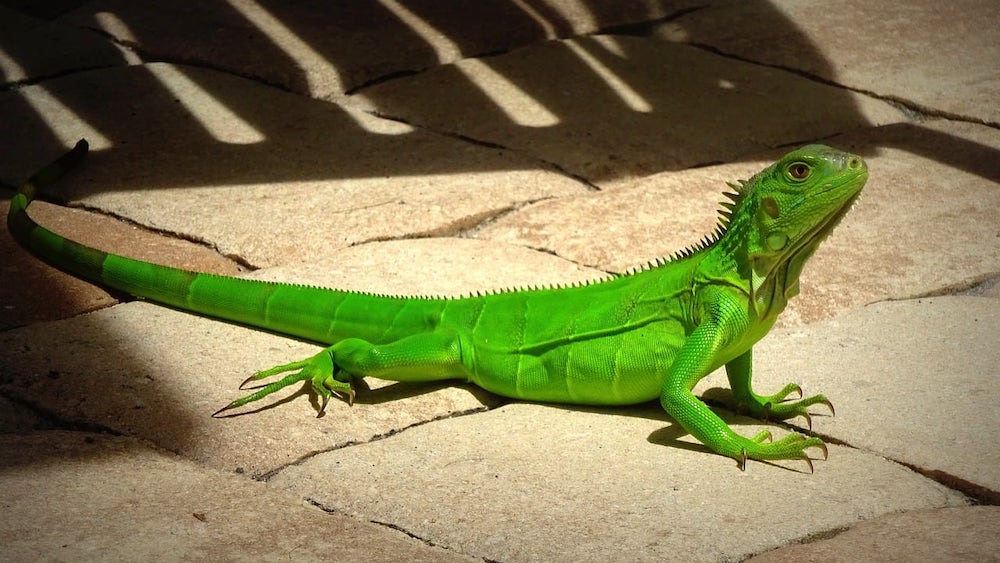Iguanas are a common sight in the warm, sunny state of Florida. These resilient reptiles are known for their adaptability to the state’s climate, but a curious phenomenon has been observed in recent years. Despite their cold-blooded nature, iguanas can become temporarily immobilized by cold temperatures, resulting in frozen iguanas scattered across the state. This blog post will explore the concept of “cold stun” events, the physiological aspects of iguanas, and the impact of lower temperatures on their behavior and metabolism.
The prevalence of iguanas in Florida is due to their non-native status and ability to thrive in the state’s warm climate. In warmer conditions, iguanas are active and can be seen basking in the sun or climbing trees. However, when temperatures drop below a certain threshold, iguanas can experience temporary paralysis, known as a cold stun event. This phenomenon has been observed in recent years, leading to widespread curiosity and concern.
The physiology of iguanas plays a significant role in their susceptibility to cold stun events. As cold-blooded animals, iguanas rely on external heat sources to regulate their body temperature. In colder conditions, their metabolism slows down, and they become sluggish. While immobilized, iguanas are at risk of injury or predation, but it is important to note that their immobilization is temporary and often reversible.
Overview of Iguanas in Florida
Non-Native Status and Adaptability
Iguanas are not native to Florida, but they have become a common sight in the state’s subtropical regions. They were first introduced to the area as pets, but many were released into the wild when they grew too large or became too difficult to care for. Since then, iguanas have established themselves as an invasive species in Florida, with populations thriving in urban and suburban areas.
Despite their non-native status, iguanas have proven to be highly adaptable to Florida’s climate. They are able to survive in a variety of habitats, including coastal areas, wetlands, and urban environments. Their ability to thrive in these diverse settings is due in part to their cold-blooded nature, which allows them to regulate their body temperature by basking in the sun or seeking shade as needed.
Typical Behaviors and Habits
One of the interesting Facts about iguanas is that in warmer weather, iguanas are active during the day, spending much of their time basking in the sun and foraging for food. They are herbivores, feeding primarily on leaves, flowers, and fruit. Iguanas are also known for their ability to climb trees and swim, making them well-suited to Florida’s subtropical environment.
Iguanas are generally docile and non-aggressive towards humans, but they can become territorial and defensive if they feel threatened. When approached by humans, iguanas may hiss, puff out their throat, or display their dewlap (a flap of skin under their chin) as a warning. It is important for residents and visitors to give iguanas plenty of space and avoid disturbing them whenever possible.
Cold Stun Events
Concept of Cold Stun
Cold stun events occur when iguanas experience temporary paralysis due to unusually cold temperatures. As cold-blooded reptiles, iguanas rely on external heat sources to regulate their body temperature. When temperatures drop below a certain threshold, their metabolism slows down, and they become sluggish. In extreme cases, they may become temporarily immobilized.
Despite the serious consequences of cold stun events, it is important to remember that iguanas are naturally adaptable animals. With proper care and attention, most iguanas can recover from a cold stun event and resume their normal activities. It is also important to remember that cold stun events are typically temporary in nature, and that iguanas are able to thrive in a wide range of environments.
Factors Contributing to Cold Stun
Several factors contribute to cold stun events in iguanas. One of the primary factors is their inability to regulate their body temperature in colder weather. Unlike warm-blooded animals, iguanas cannot generate their own body heat and rely on external sources to maintain their body temperature.
Additionally, iguanas in Florida are non-native and have adapted to the state’s warm climate. When temperatures drop below 50°F, they become susceptible to cold stun events. The frequency and severity of these events can vary depending on the duration and intensity of the cold weather.
In Florida, cold stun events are most common during the winter months when temperatures can drop suddenly and dramatically. Iguanas are particularly vulnerable to cold stun because they are not adapted to survive in cold environments. Unlike other reptiles, such as turtles, iguanas cannot burrow into the ground to escape the cold
To prevent cold stun events, iguanas seek shelter and bask in the sun for warmth. However, in extreme weather conditions, these natural adaptations may not be enough to protect them from temporary paralysis.
Overall, it is important to understand the concept of stunned iguanas events and the factors that contribute to them to ensure the safety and well-being of both iguanas and humans.
Physiology of Iguanas
Cold-Blooded Nature
Iguanas are cold-blooded reptiles, meaning that their body temperature is regulated by the environment around them. As a result, iguanas are more active in warmer weather and become sluggish in colder conditions. This is because their metabolism slows down in colder temperatures, making it more difficult for them to move and respond to stimuli.
Dependence on External Heat
Iguanas rely on external heat sources to regulate their body temperature. They bask in the sun to warm up and seek shelter in cooler areas to cool down. However, in colder weather, it can be difficult for iguanas to find a warm enough spot to regulate their body temperature. This can lead to a state of torpor, where iguanas become temporarily immobilized and unable to move or respond to stimuli.
In summary, iguanas’ cold-blooded nature and dependence on external heat make them more vulnerable to colder temperatures. This can lead to temporary immobilization during cold stun events, but iguanas typically recover and become active again when temperatures rise.
Impact of Lower Temperatures
Behavioral Changes
When temperatures drop, iguanas exhibit a range of behavioral changes. They become sluggish and less responsive to stimuli, spending more time basking in the sun or seeking shelter to conserve energy. In extreme cases, they may experience temporary paralysis, also known as “cold stun.”
During cold stun events, iguanas may fall from trees or appear dead, but they are not necessarily deceased. It’s important to approach these situations with caution and avoid touching or disturbing the iguanas, as they may still be alive and capable of biting or clawing.
Metabolic Slowdown
Iguanas are cold-blooded reptiles, meaning they rely on external heat sources to regulate their body temperature. In colder weather, their metabolism slows down, reducing their ability to move and respond to stimuli. This metabolic slowdown can also lead to a state of torpor, where iguanas become temporarily immobilized.
While immobilization may seem concerning, it is a natural adaptation that helps iguanas conserve energy and survive in colder weather. As temperatures rise, iguanas typically recover and become active again.
Overall, the impact of lower temperatures on iguanas is temporary and reversible. By understanding the natural adaptations and behaviors of these reptiles, we can better appreciate their resilience and adaptability to Florida’s climate.
Public Awareness and Safety
Importance of Awareness
It is important for residents and observers in Florida to be aware of the phenomenon of cold stun events in iguanas. These events can occur unexpectedly and may pose a risk to both human and iguana safety.
By understanding the factors contributing to cold stun events, individuals can take steps to avoid inadvertently causing harm to immobilized iguanas. Additionally, awareness can help ensure that proper precautions are taken to prevent injury to humans who may come into contact with these reptiles.
Safety Guidelines
When encountering an immobilized iguana, it is important to approach with caution. Always trust it to Iguana removal professionals. The following guidelines can help ensure the safety of both the observer and the iguana:
- Do not attempt to move or handle the iguana, as this can cause further stress and injury.
- Keep a safe distance from the iguana and avoid loud noises or sudden movements.
- If the iguana is in a high-traffic area, alert local authorities or wildlife conservation organizations for assistance.
- If the iguana is on private property, seek permission from the property owner before taking any action.
- If the iguana appears to be in distress or injured, contact a licensed wildlife rehabilitator for assistance.
By following these safety guidelines and promoting public awareness, individuals can help ensure the safety and well-being of both humans and iguanas during cold stun events.
Iguanas are susceptible to cold stun events, which occur when the temperature drops below a certain threshold. During these events, iguanas become immobilized and may appear dead. However, iguanas have a remarkable ability to recover from cold stun. In fact, many iguanas that are found in a cold stun state can be revived with proper care and attention.
Overall, iguanas are highly adaptable creatures that possess several unique traits that enable them to survive in different environments.


